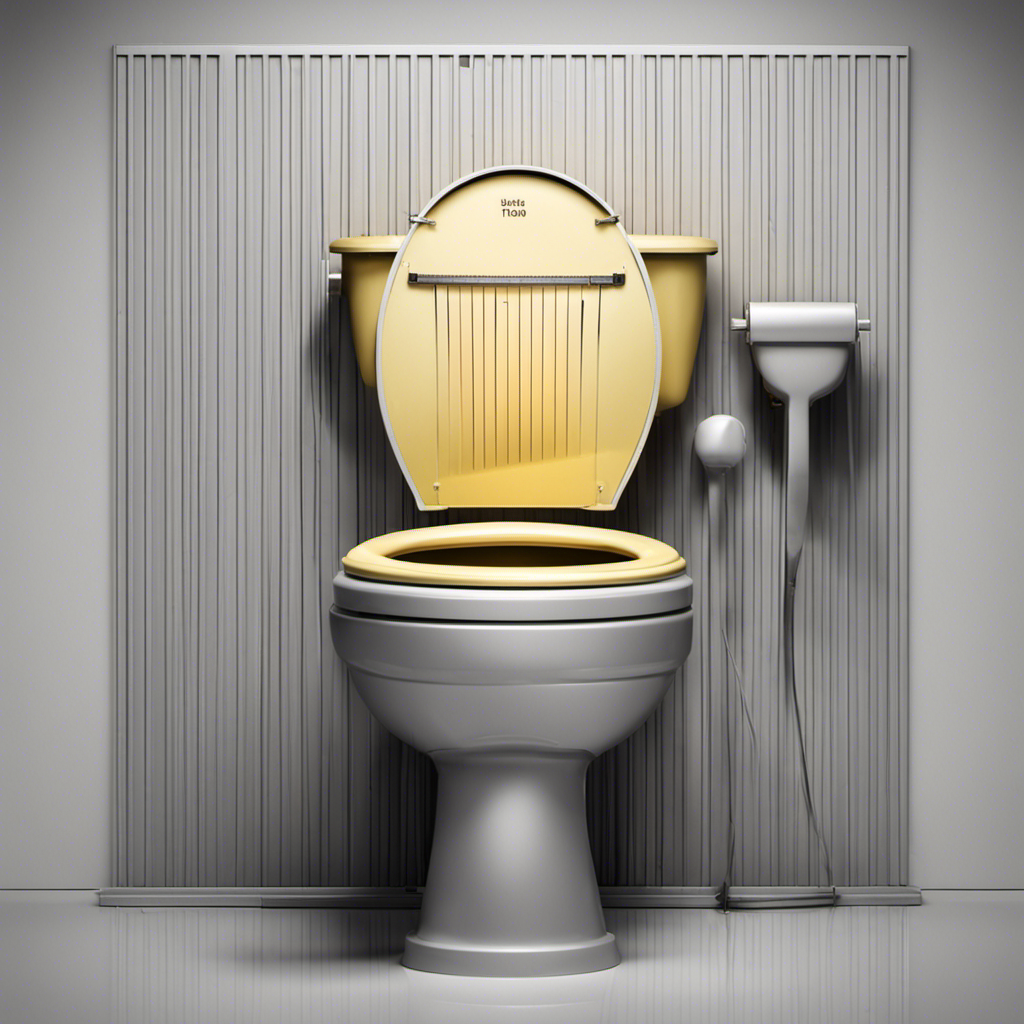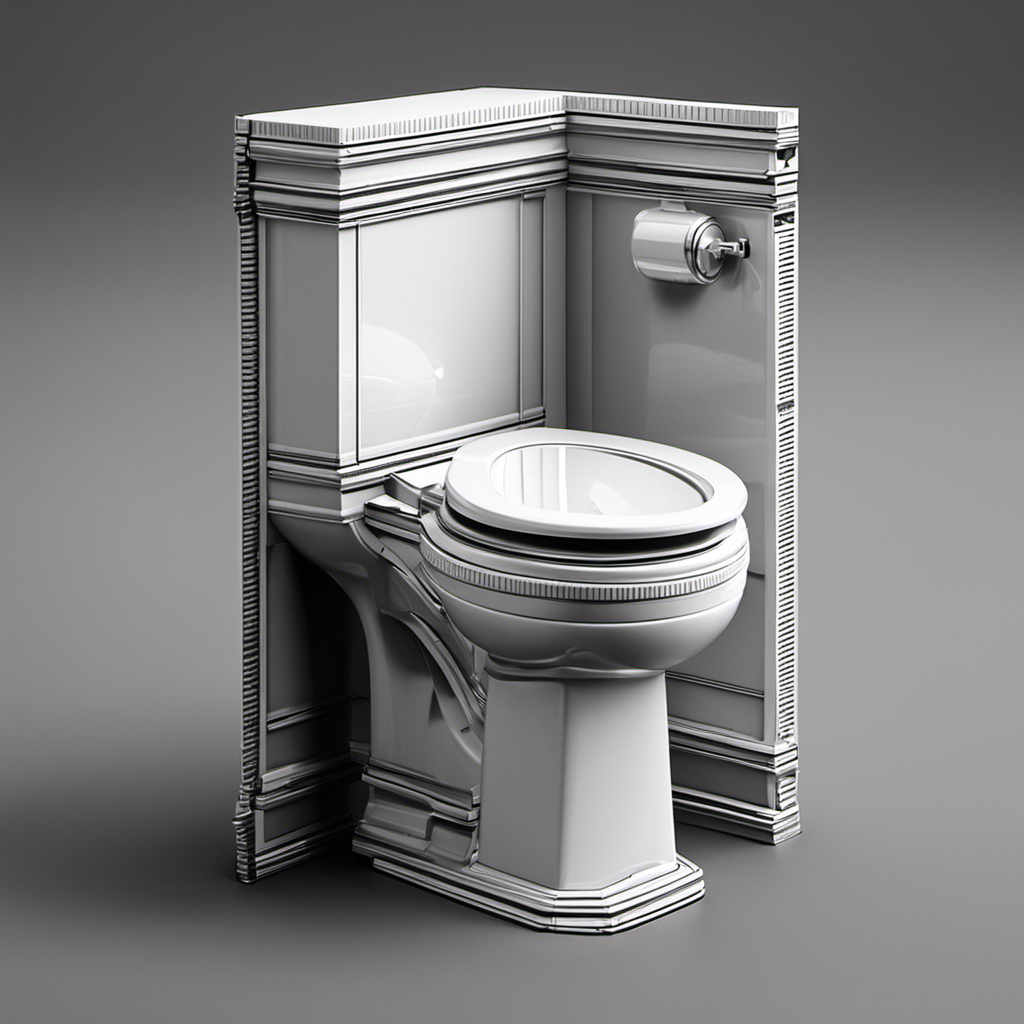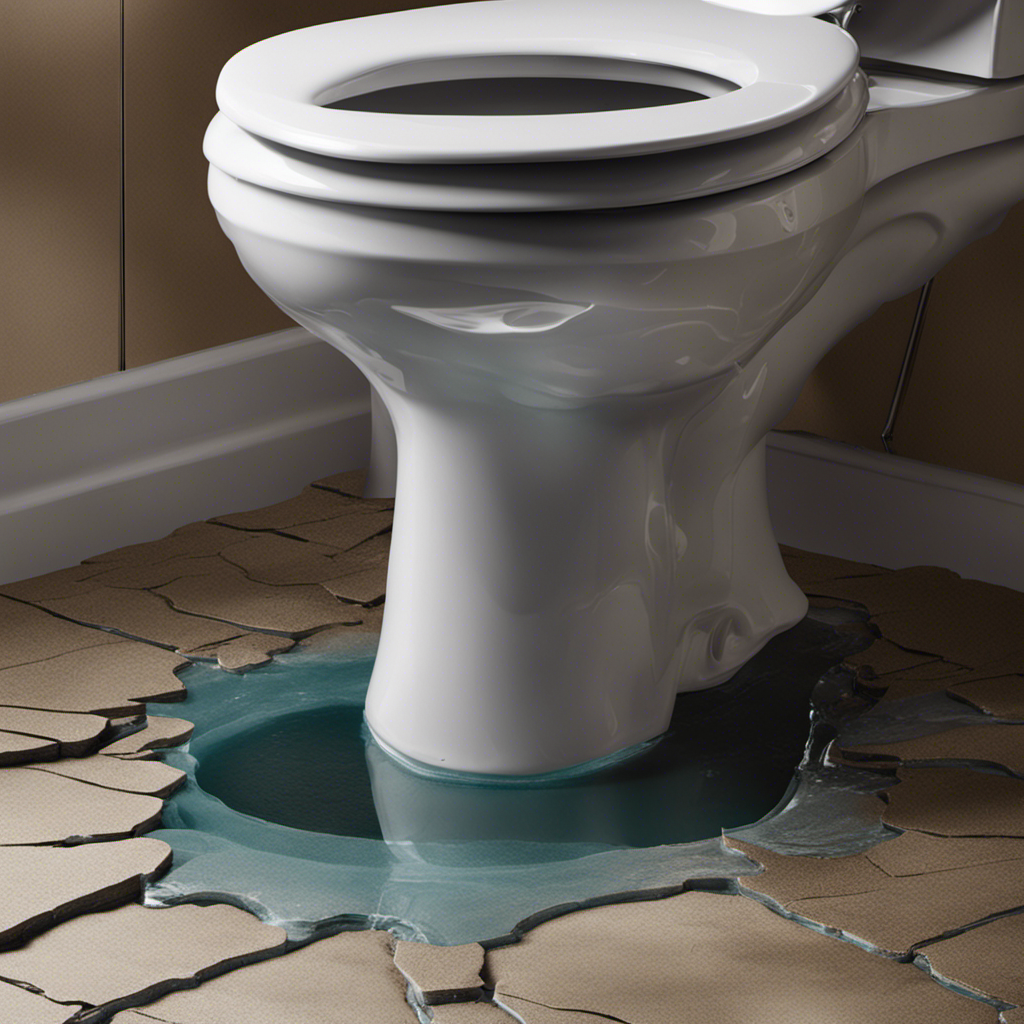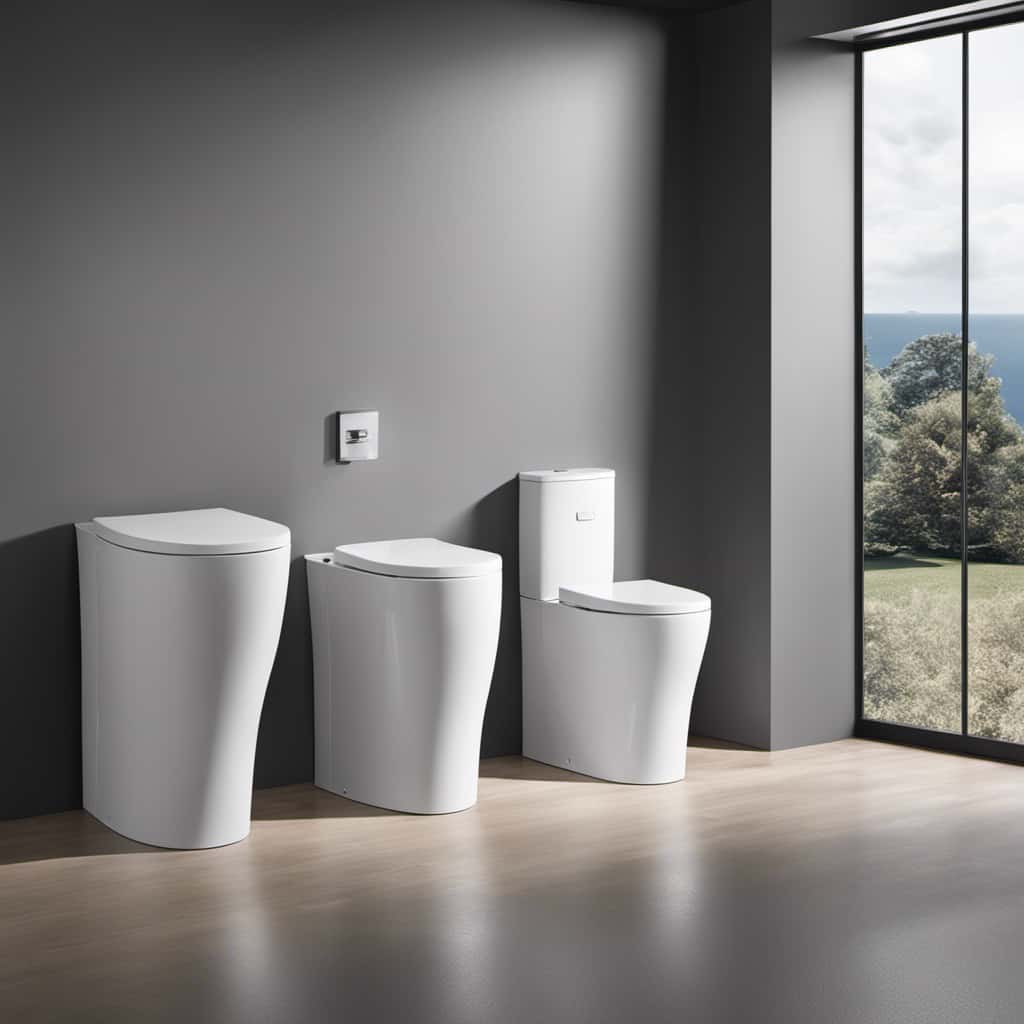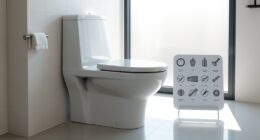Hey there! Ever wondered how to measure your toilet flapper? Well, I’ve got you covered.
In this article, I’ll walk you through the step-by-step process of measuring your flapper size, so you can find the perfect replacement.
We’ll discuss the tools you’ll need, common mistakes to avoid, and even troubleshooting tips if your flapper size doesn’t match standard measurements.
So, let’s dive right in and get your toilet flushing smoothly again!
Key Takeaways
- The toilet flapper regulates the flow of water in the toilet bowl and can cause issues if faulty.
- Accurate measurements of the flapper’s diameter, length, and width are essential for a proper fit and optimal performance.
- Guessing the size, ignoring compatibility, overlooking chain length, using the wrong tools, and neglecting wear and tear can lead to incorrect measurements and a poorly fitting flapper.
- Different types of flappers exist, including traditional, universal, and adjustable, and each type has specific dimensions that need to be measured precisely.
Understanding the Toilet Flapper
The toilet flapper is a crucial component that regulates the flow of water in the toilet bowl. It is a small, round rubber or plastic piece that is attached to the bottom of the toilet tank.
The lifespan of a toilet flapper can vary, but on average, it should last for about five years. However, there are signs that indicate a faulty flapper. One common sign is when the toilet tank constantly refills, even when it hasn’t been flushed. This could mean that the flapper is not sealing properly, allowing water to continuously leak into the bowl. Another sign is if you hear a hissing sound coming from the toilet tank, which could indicate a flapper that is not closing completely. These signs are important to recognize, as a faulty flapper can waste a significant amount of water.
Now, let’s move on to the tools needed for measuring the toilet flapper.
Tools Needed for Measuring the Toilet Flapper
When it comes to measuring the toilet flapper, having the right tools is essential. Accurate flapper measurements can help ensure a proper fit and optimal performance.
However, it’s important to be aware of common measurement mistakes that can lead to improper installations or replacements.
Essential Measuring Tools
Measuring tools you’ll need include a ruler and a tape measure. These tools are essential for accurately measuring the size and dimensions of your toilet flapper.
Here are some important tips and techniques to consider when measuring your flapper:
- Start by shutting off the water supply to your toilet and flushing to empty the tank.
- Use the ruler to measure the diameter of the flapper valve opening.
- Next, measure the length and width of the flapper itself using the tape measure.
- Take note of any additional features or attachments, such as chains or hooks, that may affect the measurements.
- When selecting a replacement flapper, consider alternative options like adjustable flappers or dual flush flappers for improved water efficiency.
- Remember to consult the manufacturer’s instructions or seek professional advice if you are unsure about the correct measurements or alternative flapper options.
Accurate Flapper Measurements
By accurately measuring your toilet flapper, you can ensure a proper fit and functionality. To achieve accurate measurements, it is crucial to follow the correct techniques and consider the available flapper sizing options. Here are some accurate measurement techniques to help you get the right size for your toilet flapper:
| Measurement | Technique |
|---|---|
| Flapper diameter | Measure the diameter of the flapper’s sealing surface using a caliper or ruler. |
| Chain length | Measure the length of the chain that connects the flapper to the flush handle. |
| Flapper thickness | Measure the thickness of the flapper using a caliper or ruler. |
Utilizing these techniques will allow you to accurately measure your toilet flapper. Properly sizing your flapper ensures optimal performance and prevents leaks. Remember to consult the manufacturer’s guidelines and consider the specific flapper sizing options available to you.
Common Measurement Mistakes
One common mistake people make is not following the correct techniques for accurate flapper measurements. Accurate measurement techniques are crucial when it comes to flapper replacement. Here are some common measurement mistakes to avoid:
-
Guessing the size: Eyeballing the size of a flapper can lead to incorrect measurements, resulting in a faulty replacement and potential water leakage.
-
Neglecting the flush valve: Ignoring the flush valve’s compatibility with the flapper can cause improper sealing and water wastage.
-
Not considering the chain length: Overlooking the chain length can result in a flapper that doesn’t open fully, leading to weak flushes.
Step-by-Step Guide to Measuring the Flapper Size
To get the correct flapper size, you’ll need to follow these step-by-step instructions.
First, shut off the water supply to the toilet and flush to drain the tank.
Next, remove the old flapper by disconnecting the chain from the flush lever and unhooking it from the overflow tube.
Measure the diameter of the flapper valve seat to determine the correct size. Most flappers come in standard sizes of 2 inches or 3 inches.
If you have an older toilet with an unusual flapper size, consider adapting the flapper design or seeking a universal flapper replacement.
Troubleshooting flapper issues, such as leaks or inconsistent flushing, can often be resolved by replacing the flapper with the correct size and ensuring proper installation.
Common Mistakes to Avoid When Measuring the Toilet Flapper
When measuring your toilet flapper, make sure to avoid these common mistakes to ensure accurate sizing.
-
Using the wrong measuring tools: It’s crucial to use a caliper or ruler with precise measurements to accurately determine the thickness of your flapper. Using improper tools can lead to incorrect measurements and ultimately, a flapper that doesn’t fit properly.
-
Neglecting to account for wear and tear: Over time, the flapper can become worn down, affecting its thickness. It’s important to measure the flapper at its thickest point to ensure a proper fit, even if it appears thinner in some areas due to wear.
-
Not considering flapper material options: Different flapper materials may have varying thicknesses. When measuring, take into account the material your flapper is made of to ensure compatibility with your toilet.
Determining the Flapper Type for Proper Measurement
Take a look at the flapper type to accurately determine the proper measurement. When it comes to flapper replacement or repair, having the correct measurements is crucial.
Start by identifying the type of flapper you have in your toilet. Common types include the traditional flapper, the universal flapper, and the adjustable flapper. Each type has specific dimensions that need to be measured precisely.
To measure the flapper, turn off the water supply and flush the toilet to empty the tank. Carefully remove the flapper and take note of its shape, size, and any unique features. Use a measuring tape to measure the diameter of the flapper and the length of the chain.
These measurements will ensure you get the right flapper for your toilet and make the replacement or repair process much smoother.
Troubleshooting: What to Do if Your Flapper Size Doesn’t Match Standard Measurements
When dealing with non-standard flapper sizes, it can be challenging to find the right fit for your toilet. In such cases, it may be necessary to adapt the flapper to ensure a proper fit.
However, it’s important to note that seeking professional assistance is always recommended to avoid any potential damage or further issues with your toilet system.
Non-Standard Flapper Sizes
There aren’t any non-standard flapper sizes available at most hardware stores. This can be frustrating for homeowners who are dealing with an uncommon toilet flapper size. However, there are alternative methods to address this issue. Here are three options to consider:
-
Contact the manufacturer: Reach out to the manufacturer of your toilet and inquire if they offer non-standard flapper sizes or if they have any recommendations for alternative solutions.
-
Custom ordering: Some specialty plumbing stores or online retailers may offer custom ordering options for non-standard flapper sizes. This can be a convenient solution, although it may come at a higher cost.
-
Flapper modification: If you can’t find a suitable replacement, you can try modifying a standard flapper to fit your toilet. This can involve trimming or reshaping the flapper to match the required size.
Using these alternative flapper sizing methods, you can overcome the challenge of finding non-standard flapper sizes and ensure proper functioning of your toilet.
Adapting Flapper for Fit
If you can’t find a suitable replacement, you could try modifying a standard flapper to fit your toilet by trimming or reshaping it. Adapting the flapper design may require some trial and error, but with the right tools and patience, it can be done successfully. Before making any modifications, it’s important to measure the dimensions of your current flapper and compare them to the standard flapper size. This will help you determine how much trimming or reshaping is needed. Additionally, there are alternative flapper options available in the market that may better suit your toilet’s unique requirements. These options include adjustable flappers, dual flush flappers, and universal flappers. By exploring these alternatives and adapting the flapper design, you can ensure a proper fit and optimal performance for your toilet.
| Flapper Type | Features | Suitable for Toilet Type |
|---|---|---|
| Adjustable Flapper | Allows customization | Standard and custom |
| Dual Flush Flapper | Provides water-saving | Dual flush toilets |
| Universal Flapper | Fits most toilet brands | Various |
Seeking Professional Assistance
Hiring a professional plumber can provide expert assistance in finding the right solution for your toilet’s flapper issue. When faced with a malfunctioning flapper, it’s easy to feel overwhelmed and uncertain about how to proceed. However, enlisting the help of a professional can offer peace of mind and ensure that the problem is resolved efficiently and effectively.
Here are some reasons why professional guidance is invaluable:
- Experience: Plumbers have years of experience working with various types of toilets and flappers, allowing them to quickly diagnose and fix the issue.
- Expertise: Professionals possess the knowledge and skills necessary to determine whether your flapper can be repaired or if it needs replacement.
- Time-saving: Instead of spending hours researching DIY solutions, hiring a plumber allows you to focus on other tasks while they handle the problem.
Additional Tips for Maintaining and Replacing the Toilet Flapper
To ensure the longevity of your toilet flapper, you should regularly clean it with vinegar and replace it every 2-3 years. Cleaning the flapper with vinegar helps remove mineral deposits and debris that can interfere with its proper functioning.
Simply remove the flapper from the flush valve, soak it in vinegar for about 30 minutes, then scrub it gently with a soft brush before rinsing it thoroughly. This simple maintenance routine can help prevent issues such as leaks and weak flushes.
However, if you’re still experiencing problems with your flapper, troubleshooting may be necessary. Check for any visible signs of damage, such as cracks or warping, and replace the flapper if needed. Additionally, make sure the flapper is properly aligned and the chain is adjusted correctly for optimal performance.
Conclusion
In conclusion, measuring the toilet flapper is a simple task that can be done with just a few tools and some basic knowledge. By following the step-by-step guide outlined in this article, you can ensure that you choose the correct flapper size for your toilet.
One interesting statistic to note is that a faulty flapper can waste up to 200 gallons of water per day, which can have a significant impact on your water bill. So, taking the time to measure and replace your flapper when needed can help save both water and money in the long run.
